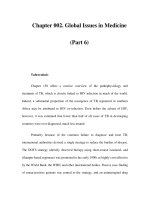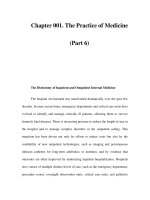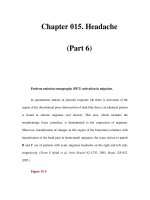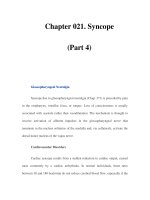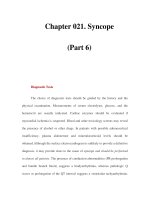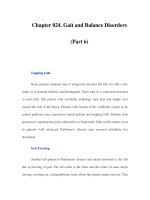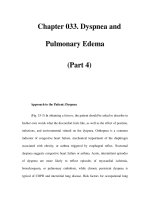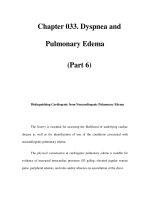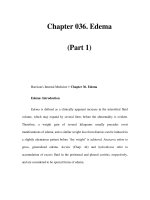Chapter 036. Edema (Part 6) ppsx
Bạn đang xem bản rút gọn của tài liệu. Xem và tải ngay bản đầy đủ của tài liệu tại đây (13.22 KB, 5 trang )
Chapter 036. Edema
(Part 6)
Edema of Heart Failure
(See also Chap. 227) The presence of heart disease, as manifested by
cardiac enlargement and a gallop rhythm, together with evidence of cardiac
failure, such as dyspnea, basilar rales, venous distention, and hepatomegaly,
usually indicate that edema results from heart failure. Noninvasive tests, such as
echocardiography, may be helpful in establishing the diagnosis of heart disease.
The edema of heart failure typically occurs in the dependent portions of the body.
Edema of the Nephrotic Syndrome
(See also Chap. 277) Marked proteinuria (>3.5 g/d), hypoalbuminemia (<35
g/L), and, in some instances, hypercholesterolemia are present. This syndrome
may occur during the course of a variety of kidney diseases, which include
glomerulonephritis, diabetic glomerulosclerosis, and hypersensitivity reactions. A
history of previous renal disease may or may not be elicited.
Edema of Acute Glomerulonephritis and Other Forms of Renal Failure
(See also Chap. 277) The edema occurring during the acute phases of
glomerulonephritis is characteristically associated with hematuria, proteinuria, and
hypertension. Although some evidence supports the view that the fluid retention is
due to increased capillary permeability, in most instances the edema results from
primary retention of NaCl and H
2
O by the kidneys owing to renal insufficiency.
This state differs from congestive heart failure in that it is characterized by a
normal (or sometimes even increased) cardiac output and a normal arterial–mixed
venous oxygen difference. Patients with edema due to renal failure commonly
have evidence of arterial hypertension as well as pulmonary congestion on chest
roentgenograms even without cardiac enlargement, but they may not develop
orthopnea. Patients with chronic renal failure may also develop edema due to
primary renal retention of NaCl and H
2
O.
Edema of Cirrhosis
(See also Chap. 302) Ascites and biochemical and clinical evidence of
hepatic disease (collateral venous channels, jaundice, and spider angiomas)
characterize edema of hepatic origin. The ascites (Chap. 44) is frequently
refractory to treatment because it collects as a result of a combination of
obstruction of hepatic lymphatic drainage, portal hypertension, and
hypoalbuminemia. A sizable accumulation of ascitic fluid may increase
intraabdominal pressure and impede venous return from the lower extremities;
hence, it tends to promote accumulation of edema in this region as well.
Edema of Nutritional Origin
A diet grossly deficient in protein over a prolonged period may produce
hypoproteinemia and edema. The latter may be intensified by the development of
beriberi heart disease, also of nutritional origin, in which multiple peripheral
arteriovenous fistulae result in reduced effective systemic perfusion and effective
arterial blood volume, thereby enhancing edema formation (Chap. 71). Edema
may actually become intensified when famished subjects are first provided with an
adequate diet. The ingestion of more food may increase the quantity of NaCl
ingested, which is then retained along with H
2
O. So-called refeeding edema may
also be linked to increased release of insulin, which directly increases tubular Na
+
reabsorption. In addition to hypoalbuminemia, hypokalemia and caloric deficits
may be involved in the edema of starvation.
Other Causes of Edema
These include hypothyroidism, in which the edema (myxedema) is located
typically in the pretibial region and which may also be associated with periorbital
puffiness; exogenous hyperadrenocortism; pregnancy; and administration of
estrogens and vasodilators, particularly dihydropyridines such as nifedipine.
Distribution of Edema
The distribution of edema is an important guide to its cause. Thus, edema
limited to one leg or to one or both arms is usually the result of venous and/or
lymphatic obstruction. Edema resulting from hypoproteinemia characteristically is
generalized, but it is especially evident in the very soft tissues of the eyelids and
face and tends to be most pronounced in the morning because of the recumbent
posture assumed during the night. Less common causes of facial edema include
trichinosis, allergic reactions, and myxedema. Edema associated with heart failure,
by contrast, tends to be more extensive in the legs and to be accentuated in the
evening, a feature also determined largely by posture. When patients with heart
failure have been confined to bed, edema may be most prominent in the presacral
region. Paralysis reduces lymphatic and venous drainage on the affected side and
may be responsible for unilateral edema.
